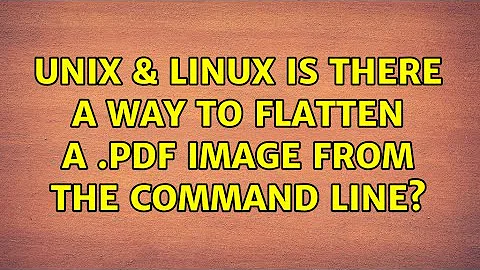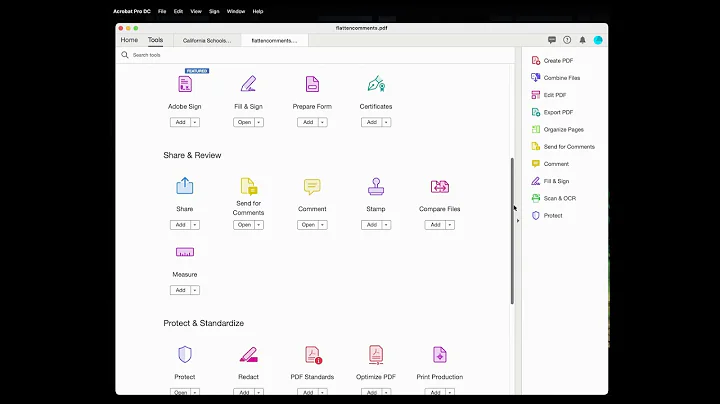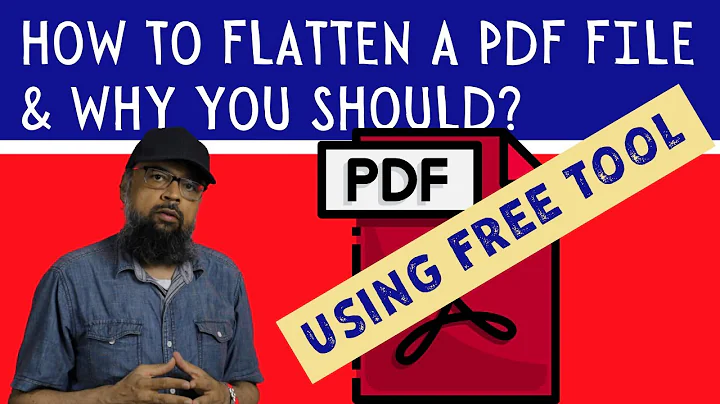Is there a way to flatten a .pdf image from the command line?
Solution 1
I found these 2 method via Google, in this thread titled: Re: Flattening PDF Files at the UNIX Command Line.
Method #1 - using Imagemagick's convert:$ convert -density 300 orig.pdf flattened.pdf
NOTE: The quality is reported to be so so with this approach.
Method #2 - Using pdf2ps -> ps2pdf:$ pdf2ps orig.pdf - | ps2pdf - flattened.pdf
NOTE: This method is reported to retain the image quality.
Solution 2
Ghostscript (gs) worked better than pdf2ps and convert for me. Quality was hardly degraded and file size is small.
gs -dSAFER -dBATCH -dNOPAUSE -dNOCACHE -sDEVICE=pdfwrite \
-sColorConversionStrategy=/LeaveColorUnchanged \
-dAutoFilterColorImages=true \
-dAutoFilterGrayImages=true \
-dDownsampleMonoImages=true \
-dDownsampleGrayImages=true \
-dDownsampleColorImages=true \
-sOutputFile=document_flat.pdf document_original.pdf
Found here: http://zeroset.mnim.org/2015/01/07/flatten-pdfs-with-ghostscript/
Solution 3
ghostscript changed their default for flattening annotations in late 2016.
To simply flatten a PDF now, you need -dPreserveAnnots=false
So a simple command line is now
gs -dSAFER -dBATCH -dNOPAUSE -dNOCACHE -sDEVICE=pdfwrite \
-dPreserveAnnots=false \
-sOutputFile=document_flat.pdf document_original.pdf
Solution 4
Although convert will keep the same file size I've found it to be slow.
The pdf2ps ps2pdf method is faster but I noticed for me it was increasing the file size.
pdftk is nice because it is not only fast but also retains a similar file size.
This is what I use to bulk flatten a directory.
function pdfflatten () {
pdftk "$1" output "$2" flatten
}
export pdfflatten
alias pdfflattenDIR='mkdir flattenedPDFs; for i in `seq $(ls *.pdf | wc -l)`; do a=`ls *.pdf | head -$i | tail -1`; pdfflatten "$a" flattenedPDFs/"$a"; done'
Related videos on Youtube
generic_user
Updated on September 18, 2022Comments
-
generic_user over 1 year
In GIMP, I can import a PDF, and use the GUI to flatten it (if it was made with many layers) by selecting
Flatten Imagein theImagedropdown menu. I can then export the PDF with a new filename.I would like to automate this. Is there some way to do it via the terminal?
-
 PersianGulf over 9 yearsinstall imagemagick and read man mogrify-im6 , montage-im6 , display-im6 , stream-im6 , identify-im6 , import-im6 , conjure-im6, composite-im6 , convert-im6 , animate-im6 and compare-im6 .
PersianGulf over 9 yearsinstall imagemagick and read man mogrify-im6 , montage-im6 , display-im6 , stream-im6 , identify-im6 , import-im6 , conjure-im6, composite-im6 , convert-im6 , animate-im6 and compare-im6 .
-
-
generic_user over 9 yearsBetter quality than GIMP on the second -- thanks!
-
 slm over 9 years@ACD - that's good to know. Glad it solved your Q.
slm over 9 years@ACD - that's good to know. Glad it solved your Q. -
eacousineau over 7 yearsUnfortunately, Method #2 does not rasterize the image, so if you are trying to block out sensitive portions, a user could still open the document and remove layers (with something like Inkscape). You can, however, modify the resolution of Method #1:
$ convert -density 150 {original,flattened}.pdfIf you need to preserve disk space, you can use-type Grayscaleor-monochromeor things of that sort. -
bksoares over 7 yearsBoth methods will rasterize the pdf, although the method #2 does it at a much higher resolution. So none of these methods are satisfying.
-
bksoares over 7 yearsThis method works great, the pdf is not rasterized and text is conserved as text
-
equaeghe about 7 yearsRegarding Method #1, also see stackoverflow.com/questions/6605006/…
-
Aidan Kane almost 6 yearspdftk flatten does not change the images within a PDF. From the docs it "merges an input PDF’s interactive form fields (and their data) with the PDF’s pages"
-
mikemtnbikes over 5 yearsI tried using this to remove a transparency layer via flattening, but it did not work for me.
-
mikemtnbikes over 5 yearsTo be clear, this approach doesn't flatten transparent layers (as indicated above).
-
ste over 4 yearsIt changed a font for me but otherwise much better resolution than the other proposed methods.
-
 Alexus about 4 yearsI'm using this for resizing notes. Method 2 took ages to convert 12 pages from 2 MB to 70 MB (pdf->ps) and back (ps -> pdf). Ghostscript did it faster.
Alexus about 4 yearsI'm using this for resizing notes. Method 2 took ages to convert 12 pages from 2 MB to 70 MB (pdf->ps) and back (ps -> pdf). Ghostscript did it faster. -
 Alexus about 4 yearsIs there a way to do this with batch files in place?
Alexus about 4 yearsIs there a way to do this with batch files in place? -
carter over 3 yearsWhen I run the
convertcommand I get an error. My PDF is only text, no images. error:convert: no decode delegate for this image format `' @ error/constitute.c/ReadImage/562. convert: no images defined `no_protect_raster.pdf' @ error/convert.c/ConvertImageCommand/3285. -
 Kayofeld over 3 yearsThe second method increase the size of my PDF more than 10x, and lost text highlighting annotation created with Evince.
Kayofeld over 3 yearsThe second method increase the size of my PDF more than 10x, and lost text highlighting annotation created with Evince. -
 JayDin over 3 yearsThanks, worked well for me. This command seems to give the same output as Stan Bondi's answer while being simpler. Both were much quicker and gave a smaller file than using
JayDin over 3 yearsThanks, worked well for me. This command seems to give the same output as Stan Bondi's answer while being simpler. Both were much quicker and gave a smaller file than usingconvert. -
sebastian about 3 yearsThis did not work for me, I get "Unrecoverable error: rangecheck in .putdeviceprops". The ps2pdf solution above did work.
-
andreas1724 almost 3 yearsGot also "Unrecoverable error: rangecheck in .putdeviceprops". The ghostscript-answer from user107769 did work.
-
 Dan Ortega over 2 yearsThis works awesome
Dan Ortega over 2 yearsThis works awesome




